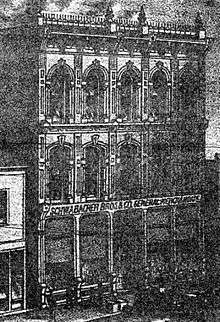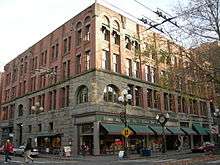William E. Boone
| William E. Boone | |
|---|---|
| Born |
September 3, 1830 Pennsylvania, U.S. |
| Died |
October 29, 1921 (aged 91) Seattle, Washington, U.S. |
| Occupation | Architect |
William Boone (3 September 1830, in Pennsylvania – 29 October 1921, in Seattle, Washington) was an American architect who practiced mainly in Seattle, Washington from 1882 until 1905. He was one of the founders of the Washington State chapter of the American Institute of Architects as well as its first president.[1] For the majority of the 1880s, he practiced with George Meeker as Boone and Meeker, Seattle's leading architectural firm at the time. In his later years he briefly worked with William H. Willcox as Boone and Willcox and later with James Corner as Boone and Corner. Boone was one of Seattle's most prominent pre-fire architects whose career lasted into the early 20th century outlasting many of his peers. Very few of his buildings remain standing today, many being destroyed in the Great Seattle fire. His most well known commissions were the Yesler – Leary Building and the Henry Yesler House as well as many of Seattle's earliest brick buildings and some still standing in the Pioneer Square district.
Early life
William E. Boone was born in Pennsylvania on September 3, 1830 and was raised there.[2] He moved to Chicago as a young man and worked in construction as a carpenter for a railroad company before becoming involved with building design in Minneapolis around 1853. In 1859 he relocated to the San Francisco Bay Area where he resided for twenty years as a builder-contractor. He first visited the Puget Sound region in 1870 where he appears in the 1870 United States Census as residing in Olympia, Washington.[3] While there he designed several small structures in and around that city and oversaw the construction of the federal prison at nearby McNeil Island, Washington.[4]
Seattle, Boone and Meeker
He returned to Seattle permanently in 1881 where he worked between there and Tacoma. In 1883, he formed the partnership of Boone and Meeker with George Meeker of Oakland, California, who is thought to have remained in Oakland for the majority of their partnership.[4] In Seattle, Boone designed mostly commercial buildings, being responsible for most of the city's earliest brick buildings. In 1883, his design was chosen for Henry Yesler and John Leary's business block at the corner of Front (First) Street and Mill (Yesler) Street. The design, based on San Francisco's original Phelan Block (1878–1881, destroyed) featured high Italianate and Second Empire detail and a prominent octagonal turret. It was described by local newspapers as Seattle's "finest building and symbolic of the city's new metropolitan character." Boone and Meeker located their offices in the new building where they remained until the fire. Boone planned a four story addition to the Yesler – Leary Building but as Seattle's first building boom began to wind down in 1884, these plans were shelved.[5][6] The building was eventually built in 1888 but only at three floors and in a more subtle style by Boone.

At the same time of the Yesler – Leary Building, Boone was also preparing plans for a new residence for Henry Yesler. Completed in 1884, It was categorized as Eastlake style but combined elements of Victorian, Queen Anne and Eastlake. The home occupied an entire city block and was Seattle's largest home at the time. By 1884, Boone and Meeker shifted their focus to Tacoma, whose building boom continued while Seattle's waned. There they designed the Annie Wright School and several other commercial and residential structures.[6]
By 1887, Seattle's economy began to rebound and construction activity was picking back up. Boone and Meeker resumed their position as the city's leading architect with several large commercial buildings. Architectural trends were moving away from the highly decorated Italianate buildings clad in stucco and cast iron and more towards rusticated stone and exposed brick. This was shown in one of the firm's first projects of 1887, the Toklas & Singerman Building at the corner of First and Columbia Streets.[7] The following year, Boone oversaw the construction of one of Seattle's first modern office buildings, the Boston Block at Second and Columbia. It housed the city's first passenger elevator and was one of the very few buildings in downtown to survive the great fire in 1889.[8] In 1888 the firm submitted two different designs in a bid for Seattle's first two brick school houses. The school district wound up choosing both.[9] Boone and Meekers first buildings in 1889 included the Ramona Hotel (now demolished) and the I.O.O.F. Building in Belltown, one of his earliest surviving designs.[8]
Post-fire years
Following the destruction of his offices in the Yesler – Leary Building in the Great Seattle Fire, Boone moved the firm's offices into the Boston Block that was largely undamaged. By 1890, Boone was entering his 60's and his designs were becoming dated.[10] His partnership with Meeker was dissolved in 1889 and he was once again a solo architect. The building boom following the great Seattle fire was attracting many younger architects with fresh ideas such as Elmer Fisher to the area who soon replaced Boone as Seattle's top architect. Boone was still a respected architect in the city and continued to work, designing such buildings as the Marshall – Walker Building (a.k.a. the Globe Building) in Pioneer Square and the massive New York and Occidental Buildings, both which were replaced by the Dexter Horton Building in 1922.[11][12] The New York Block was credited to the short-lived firm of Boone and William Willcox from 1891 to 1892 but the design is largely credited to Boone.[13] Boone moved his offices into the New York Block following its completion. These later buildings displayed a more simplified design along the lines of Romanesque Revival architecture that emerged in the late 1880s, shaped by the influence of Henry Hobson Richardson, as well as Burnham and Root and other architects of the Chicago School, much in contrast to most of Boone's previous work and architectural knowledge.[14] Boone and Willcox were also architects of the Plymouth Congregational Church, a building that reflected Willcox's previous experience in church design in the American Midwest.[15]
In 1891, Boone and Willcox were selected to plan the new campus for the University of Washington. The plan that included 16 buildings was halted after ten days of construction as a result of flaws in the legislation that created the university. When construction resumed in 1893, the firm's plans were dropped in favor of a competition for a single main building won by Charles Saunders.[16] Boone had little work in the years following the Panic of 1893. It appears he only designed several small residences and one commercial building.[1]
Late career and death
In 1894, Boone helped instigate the Washington State chapter of the American Institute of Architects (AIA), laying the foundation for the architecture profession in Washington. Boone was elected the chapter's first president. In 1900 he formed a new partnership with James Corner, who had formerly worked with Warren Skillings. One of their biggest projects and one of Boone's last was the stone Seattle High School (later known as Broadway High School) in 1902 and 1903. After 1905 Boone reduced his practice activities and by 1910 had retired altogether. He died in Seattle in October 1921 at the age of 91.[17]
Projects


Boone and Meeker
- City Building (1882, Destroyed) – Second Street S., Seattle
- Marshall Building (1882, Destroyed) – Commercial Street (now 1st Ave. S.), Seattle
- McNaught, Walker & Renton Building (1882–3, Destroyed) – Commercial Street (now 1st Ave. S.), Seattle
- Boyd & Poncin Building (1882, Destroyed) – Front Street (now 1st Ave.), Seattle
- Yesler – Leary Building (1882–3, Destroyed) – now NE corner of 1st Ave. and Yesler Way, Seattle
- Carliss P. Stone Block (1883, Destroyed) – Front Street (now 1st Ave.), Seattle
- Schwabacher Building (1883, Destroyed) – Yesler Way West of 1st Ave., Seattle
- Wah Chong Building (1883, Destroyed) – S. 3rd St., Seattle
- Watson Squire Building (1883, Destroyed) – S. 2nd St., Seattle
- Eben A. Osborne House (1884, Destroyed) – 1124 4th Ave., Seattle
- Bishop Paddock House (1884, Destroyed) – Division & Tacoma Streets, Tacoma
- Henry Yesler House (1883-4, Destroyed) – 3rd, 4th, James and Jefferson Streets, Seattle
- Wilkeson & Kandle Building (1884, Destroyed) – Pacific near 11th, Tacoma
- Seattle Safe Deposit Building (1884, Destroyed) – Front Street (now 1st Ave.), Seattle
- Gordon Hardware Building (1884, Destroyed) – Front Street (now 1st Ave.), Seattle
- Annie Wright Seminary (1883-4, Destroyed) – 611 Division Ave., Tacoma
- Washington College (1885, Destroyed) – 714 Tacoma Ave. S., Tacoma
- Territorial Insane Asylum (1886-7, Destroyed) – Steilacoom
- Toklas & Singerman Building (1887, Destroyed) – 1st Ave. and Columbia, Seattle
- Charles L. Denny House (1887, Destroyed) – Seattle
- Yesler Block (1887-8, Destroyed) – adjoining Yesler – Leary Building, Seattle
- I.O.O.F. Building [Barnes Building] (1889) – 2320–2322 1st Ave., Seattle
- South School (1888-9, Demolished) – Seattle
- Central School (1888-9, Demolished) – Seattle
William Boone

- Phinney Building [Carleton Block/Ramona Hotel] (1889, Demolished) – Seattle
- Wah Chong Building [Phoenix Hotel] (1889, Demolished) – 2nd Ave. S. and S. Washington Street, Seattle
- McNaught Building (1889, Destroyed) – S.E. corner of Second S. at Washington, Seattle
- Sanderson Block [Merchants Cafe] (1889), Yesler Way, Seattle
- Post – Edwards Block [The Lusty Lady] (1890) 1315 1st Ave., Seattle
- Marshall – Walker Building (1890–91) – 1st Ave. S. and Main, Seattle
- Dexter Horton Building [Occidental Building] (1889, Destroyed) – NW corner of 3rd & Cherry, Seattle
- Leary – Walker Building (1893, Destroyed) – 2nd Ave., Seattle
- 5-story building for Cyrus Walker (1899–1900, Destroyed) – NW corner of 2nd & Spring, Seattle
Boone and Willcox
- New York Block (1890–92, Demolished) – NE Corner of 2nd & Cherry, Seattle
- McKenney Block (1890–91, Destroyed) – 4th & Capitol Way N., Olympia
- Plymouth Congregational Church (1891-2, Destroyed) – 3rd & University, Seattle
- Walker Building (1891–2) [only 1 floor built] – Occidental St., Seattle
- J.M. Frink Building [Washington Shoe Building] (1891–2) – SE Corner of Occidental and Jackson, Seattle
Boone and Corner

- Seattle High School (1902-3, demolished; surviving auditorium was designed by Edgar Blair) – Broadway, Seattle
- Walker Block [Seattle Quilt Building] (1903) – 316 1st Ave. S., Seattle
Notes
- 1 2 Ochsner, p. 20
- ↑ Ochsner, p. 19
- ↑ 1870 United States Census, United States Census, 1870; Olympia, Thurston, Washington Territory; roll M593_1683, page 227B, line 1. Retrieved on 2010-03-10.
- 1 2 Ochsner & Andersen, p. 32
- ↑ Ochsner & Andersen, p. 33
- 1 2 Ochsner & Andersen, p. 34
- ↑ Ochsner & Andersen, p. 40
- 1 2 Ochsner & Andersen, p. 41
- ↑ Ochsner & Andersen, p. 42
- ↑ Ochsner & Andersen, p. 161
- ↑ Ochsner & Andersen, p. 180
- ↑ Ochsner & Andersen, p. 162-3
- ↑ Ochsner & Andersen, p. 98-9
- ↑ Ochsner & Andersen, p. 164
- ↑ Ochsner & Andersen, p. 238-40
- ↑ Ochsner, p. 18
- ↑ Ochsner & Andersen, p. 286
References
- Ochsner, Jeffrey Karl; Andersen, Dennis Alan (2003). Distant Corner: Seattle Architects and the Legacy of H.H. Richardson. Seattle: University of Washington Press. ISBN 978-0-295-98238-0.
- Ochsner, Jeffrey Karl (1998). Shaping Seattle Architecture: A Historical Guide to the Architects [Corrected]. Seattle: University of Washington Press. ISBN 978-0-295-97366-1.
- MacIntosh, Heather M. (October 21, 1998). "Boone, William E. (1830–1921)". Historylink.com. Retrieved January 20, 2010.